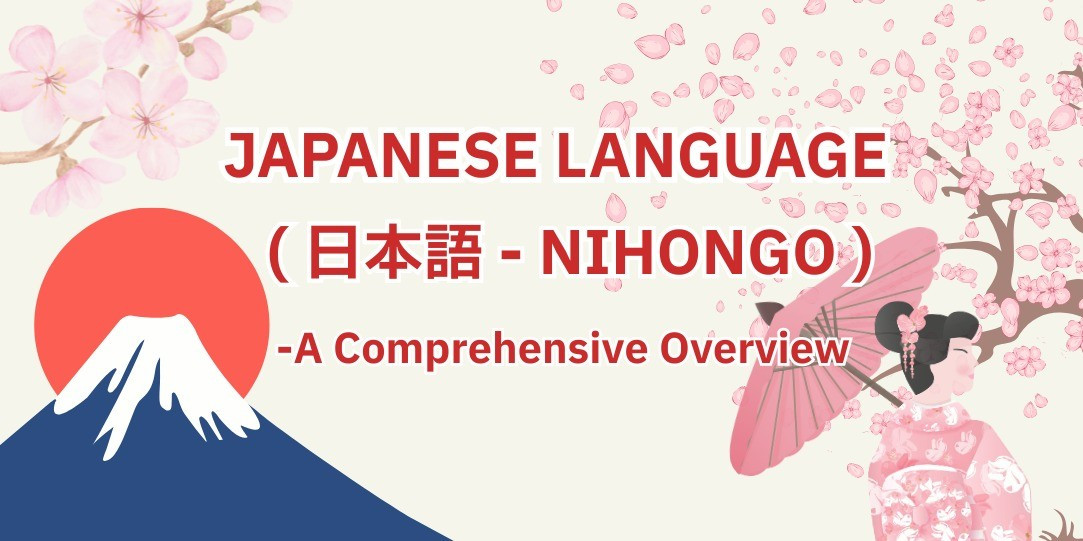
Japanese Language (日本語 - Nihongo): A Comprehensive Overview
1.
Origins and Language Family
The exact
origin of the Japanese language remains uncertain. It is classified as a
language isolate, meaning it has no proven relationship with any
other language family. However, some scholars suggest possible distant
connections with Korean, Altaic languages, or the Austroasiatic
language group, though none of these theories have been universally
accepted.
What we do
know is that Old Japanese emerged around the 8th century, heavily
influenced by Classical Chinese, particularly in written form. Over
time, Japanese developed its own syntax, vocabulary, and phonetic
systems, although many Chinese-origin words (Sino-Japanese words)
remain integral to the modern language.
2.
Writing Systems
Japanese
is written using a combination of three scripts:
a. Hiragana
(ひらがな)
- Used for native Japanese
words, grammatical elements, and words without Kanji.
- Consists of 46 basic
characters.
- Simple, curved characters;
usually the first script taught to learners.
- Example: たべます (tabemasu – to eat)
b. Katakana
(カタカナ)
- Used for foreign loanwords,
technical terms, emphasis, and onomatopoeia.
- Also consists of 46 basic
characters, but with sharp, angular strokes.
- Example: コンピューター (konpyuutaa – computer)
c. Kanji
(漢字)
- Chinese characters adopted
into Japanese.
- Represent meanings and ideas,
not just sounds.
- Thousands of Kanji exist;
native Japanese are expected to know around 2,136 Jōyō Kanji
(commonly used Kanji).
- Each Kanji may have multiple
readings (onyomi – Chinese reading; kunyomi – native reading).
- Example: 食 (shoku/taberu – to eat)
Roman
letters (Romaji)
are also used, especially for learners and technology-related contexts, but
they are not used in standard Japanese writing.
3.
Grammar Structure
Japanese
grammar is very different from English or most European languages:
- Sentence Order: The basic word order is Subject – Object – Verb (SOV).Example: 私はリンゴを食べます (Watashi wa ringo o tabemasu – I eat an apple).
- Particles: Small words placed after nouns, pronouns, or verbs to indicate the role of the word in the sentence.Examples: は (topic marker), を (object marker), に/で (direction/place/time), か (question marker).
- No Plurals or Articles: Unlike English, Japanese
doesn’t use “a,” “an,” or “the,” and plural forms are often understood
through context.
- Tenses: Primarily two tenses – past and non-past (present/future).Example: 食べる (taberu – eat/will eat), 食べた (tabeta – ate)
- Verb Conjugation: Verbs change forms based on
tense, politeness, or mood (e.g., negative, potential, conditional).
- Adjective Conjugation: Japanese adjectives can also change form to express tense and negativity.Example: 高い (takai – expensive), 高くない (takakunai – not expensive)
4.
Politeness and Honorifics (Keigo 敬語)
One of the
most defining aspects of the Japanese language is keigo, or levels of
politeness. Japanese society places a high value on hierarchy, and the
language reflects this with different forms of speech depending on the
relationship between the speaker and listener.
There are three
main levels of politeness:
- Teineigo (丁寧語) – Polite language; used in
most daily conversations and with strangers.
- Sonkeigo (尊敬語) – Honorific language; used to
show respect to others (e.g., superiors, customers).
- Kenjōgo (謙譲語) – Humble language; used to
humble oneself or one’s in-group when talking to others.
Learning
when and how to use these appropriately is essential for effective
communication in professional and social contexts.
5.
Pronunciation and Phonetics
Japanese
pronunciation is relatively simple compared to other languages:
- It has only five vowels:
a (あ), i (い), u (う), e (え), o (お).
- Each syllable (mora) tends to
be pronounced clearly and evenly.
- It lacks stress accents like
English, instead using pitch accent to distinguish meanings in some
cases.
- Example: hashi (橋 – bridge) vs. hashi (箸 – chopsticks)
There are
no consonant clusters or complex sounds, which makes spoken Japanese
easier to pronounce for beginners. However, getting used to pitch accent
can take time.
6.
Vocabulary: Native, Sino-Japanese, and Foreign Words
Japanese
vocabulary consists of:
- Wago (和語): Native Japanese words.
- Kango (漢語): Sino-Japanese words borrowed
from Chinese.
- Gairaigo (外来語): Foreign loanwords, mostly
from English, written in Katakana.
Examples:
- Wago: みず (mizu – water)
- Kango: 水道 (suidō – water supply)
- Gairaigo: ウォーター (wōtā – water [loaned from
English])
This layered
vocabulary system adds richness to the language, allowing speakers to
choose words based on tone, context, and formality.
7.
Cultural Relevance
The
Japanese language is deeply tied to Japanese culture, values, and
history. Its structure and usage reflect the importance of harmony (和 - wa), group identity, respect
for elders, and non-verbal communication. Even silence (間 – ma) plays an important
communicative role in Japanese.
Language
is also central to various traditional arts and expressions, including haiku,
calligraphy (書道
shodō), tea
ceremony (茶道
sadō), and Noh/Kabuki
theater. Moreover, modern Japanese is shaped by pop culture such as anime,
manga, J-pop, and video games, which has made the language
increasingly popular worldwide.
8.
Learning Japanese: Challenges and Rewards
Challenges:
- Complex writing system, especially Kanji.
- Politeness levels (keigo) that require understanding of
social context.
- Ambiguity in spoken language due to
omitted subjects/objects.
- Multiple readings of Kanji, requiring extensive
memorization.
Rewards:
- Gain access to a rich and
unique culture.
- Increased job opportunities in
business, tourism, and translation.
- Understand Japanese media
in its original form.
- A deeper appreciation of Eastern
philosophies and aesthetics.
Many
learners start with spoken Japanese and Hiragana/Katakana,
gradually adding Kanji as they progress. Language schools, JLPT (Japanese
Language Proficiency Test), online platforms, and immersion in Japanese
communities are common strategies to improve proficiency.
Conclusion
The
Japanese language is more than just a method of communication; it is a window
into one of the world’s oldest, richest, and most refined cultures. While it
poses challenges to new learners, it offers countless opportunities for
personal growth, cultural appreciation, and professional development. Mastering
Japanese requires patience, dedication, and cultural curiosity—but for those
who commit, it is a deeply rewarding journey.


hello I am mobile app developer